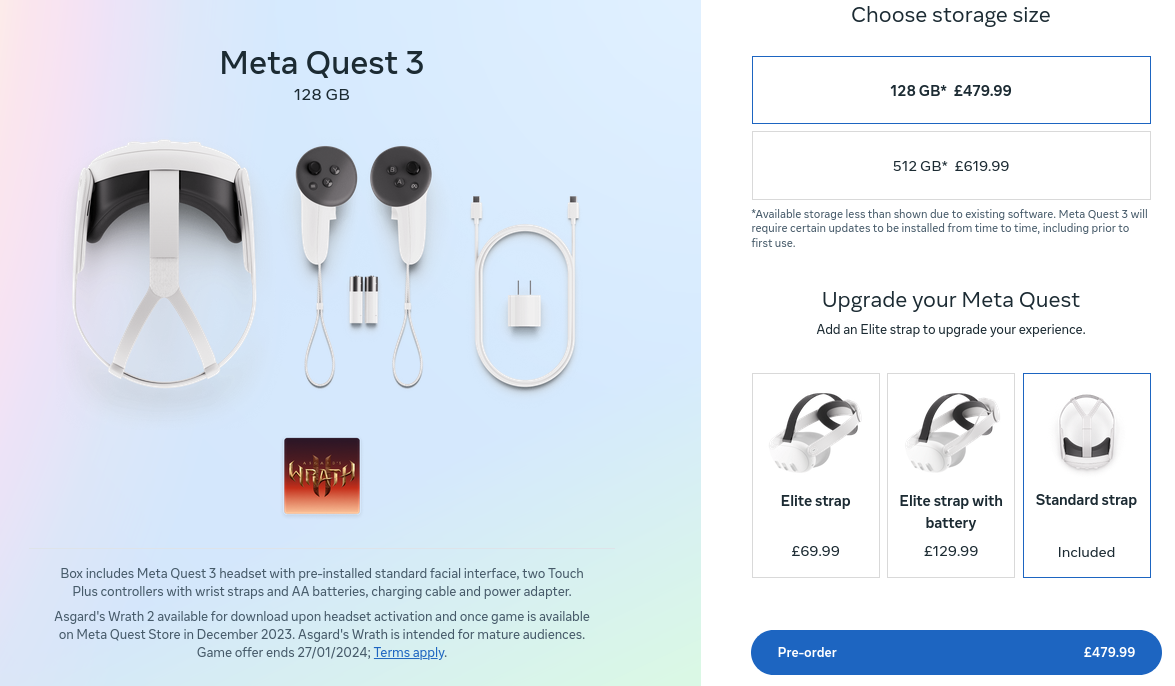Ah, I really wish Oculus had sold themselves to almost any other company on the planet :(
I’d be curious to see how things would have played out without them acquiring Oculus.
At the very least Meta is loosing billions with their VR adventure, so if nothing else, they’re not doing something else potentially way worse with this money.
What else could they do? They’re already big in AI. Just more share-buy-backs to pump the price most likely?
So you still need an account to use this, it is it just hardware?
Does it work on Linux?
@detalferous@lemm.ee You don’t need a Facebook account, but you will need a Meta account, which is arguably basically the same thing.
It’s a stand-alone android machine, so it’s using a linux kernel most likely. But that isn’t what you mean. You won’t be able to easily wipe the OS and install anything else.
Not sure if it has a link-cable to connect to a Steam PC like the Quest2 had. If so then that will work to connect it to Linux just as well as any other headset, but VR on Linux/Steam in general is pretty poor.
If I buy one I’ll ban it from WIFI except when actually downloading games.
@fer0n@lemm.ee
Super informative. Thank you.
Looks like you do?
Meta Quest+ Subscription Get two handpicked titles every month. Included with purchase of 512GB model.***
Fuck off Zuckerberg
Why do I keep seeing this comparison over and over? Like cool, you compared it to the absolute cheapest headset out there, Meta loses money on every one of them they’ve sold. It’s also a VR experience only, with awful external cameras. The $1099 HTC Vive XR Elite would be a much fairer comparison as it also does AR and VR together.
It’s the same as all the articles comparing other devices not using an external battery pack. When those are using smartphone-tier ARM chips that can’t hold a candle to Apple’s M-series SoCs.
Like, I still think it’s overpriced as fuck but I’d really love to see some actually realistic comparisons.
Honestly, if you’re comparing any two headsets, these make the most sense imo. They’re from the two biggest companies, the Q3 will presumably sell the most out of any headset and it‘s shifted to a lot more mixed reality.
They feel the most relevant, although there are certainly many differences. I think at the end of the day there isn’t really any headset that perfectly compares to VP, simply due to the fact that VP has a very heavy work focus and everything else is mostly game focused. Quest pro perhaps, but that headset is a joke.
Varjo headsets. Apple actually used Varjo’s headsets to test out the software for the Vision Pro while developing it. There isn’t any software specifically for the Varjo headsets since its just business focused.
Apple’s headset is much cheaper than Varjo’s, somehow, despite having similar tech.
Yeah see, this is the exact comparison I’ve been dying to read. If Apple managed to pull off cost-reducing that grade of hardware then they’ll probably carve out a nice niche for themselves. They never designed it for mass-market adoption.
It was the same with everyone complaining about the cost of the XDR display. Not a single one of them were in the target market for it. People that were, were all talking about them pulling off matching the specs of an $8-10k reference monitor for $5k.
Also, Varjo charges a €1495/year subscription for their high end XR headset that already costs €6495. If the VP truly is close too or as good as it, then Apple are definitely going to sell a lot to professionals and creatives.
No One is going to be using a bloody Meta Quest for creative or professional work.
They feel the most relevant, although there are certainly many differences.
Many differences? They are completely different products. This is like comparing a Switch to a laptop. Sure, they are both computers but the comparison ends there.
I think that in an already niche market, it is hard for the average consumer to even further differentiate them into their own niches.
Plus, they’re in the same market. I can’t see someone owning both because they have completely different use cases. If you buy one of them you basically already can do most of what the other one can.
It’s kinda like comparing a Honda Civic to a Ferrari. Yeah they are different, but they are still cars and have a lot in common.
If you buy one of them you basically already can do most of what the other one can.
But that’s the point, they aren’t even remotely similar. The only similarity is that they are headsets, but they couldn’t be more different functionally.
It’s kinda like comparing a Honda Civic to a Ferrari.
More like comparing a Honda Civic to an airplane. Both have wheels, but that’s where the similarities end. They aren’t even in the same market.
The Vision Pro isn’t competing with the Quest, it’s competing with the MacBook Pro and iMac.
Dude you’re just way off. They aren’t that dissimilar. They both are pass through vr headsets. Quality doesn’t change their function.
Typical techie way of looking at things. It’s not about the technology at all. It’s about what you can do with it. One is an AR headset, the other a spatial computing headset.
They both have AR and Spatial Computing capabilities at varying quality. They are both a set of lenses, a depth sensor, some cameras, and some screens, nothing more nothing less. Cars have wheels and planes have wings, that’s not an apt comparison.
Yes, they are quite different. But it’s also the two products that most people will know or have heard of and they may look the same to many not familiar with AR/VR. At the very least for them it’s an interesting comparison.
Heeey, HTC one actually looks pretty cool!
Not that I am interested in one, but if I was after something that Meta sold, I would buy something else
Something else from Meta or the same thing by another company?
Not OP, but “something else from another company” is the only thing that makes sense.
So not related at all is what you’re saying? (⁀ᗢ⁀)
There are lots of VR headsets out there
Even heavier with weight still completely concentrated on the front.
I don’t get it. The Pico 4 moved batteries to the back of the headstrap and suddenly was actually comfortable. I can’t imagine that’s hard to do.
Why keep doing the “old” Quest style? It sucks.
They can sell you a 100 dollar elite strap if the strap has nothing and is removable.
No they can’t. We all found out during the Quest 2 era that their elite straps are fragile and prone to snapping. 100% of the advice in the community is to buy third-party.
The vast majority of people aren’t going to be in the community though. They will keep selling stuff like that.
deleted by creator
It doesn’t stick out from your face nearly as far as the q2. The weight is more central. I’m sure it feels fine.
Q3 being a budget version, it’s probably cheaper and has the advantage of swappable head straps as well as letting you rest your head on the couch or bed. It does move the weight closer to your head at least, but Vision Pro does the same thing. They decided to rather go for an external battery than putting anything in the back.
I’ll most certainly put something heavy back there to balance it out, the best thing for comfort you can do. I‘d definitely love to have the battery itself there, but I see why they’re doing it this way.
Elite-strap with battery appears to be a thing they try and up-sell you with upon ordering.
Needs to have a front battery in order to flog a back-battery?

They could pay me and I still wouldn’t venture into their data collection hell. Good thing there are better alternatives.
Completely reasonable stand point, due to meta being meta. Depends on what you’re looking for, for standalone VR, Quest has sadly been the only real option for a long time. And unless the company behind it is the only factor, Quest is still the best option with the price, hardware, and game library.
Others are slowly creeping up, the main one being Pico, but that has it’s own issues. Which one did you have in mind?
My abstract for the linked article
Click to expand
Meta today announced its new $500 Meta Quest 3 virtual reality headset, which features improved resolution, processing power, and comfort over the Quest 2. Meanwhile, Apple is preparing to launch its high-end $3,500 Vision Pro mixed reality headset next year with 4K displays offering 23 million pixels. The Quest 3 uses Qualcomm’s new Snapdragon XR2 Gen 2 chip and improved cameras for augmented reality experiences similar to the Vision Pro. Weighing over a pound, the Quest 3 includes updated lenses and fabric strap for comfort. Its controllers offer haptic feedback and camera-based navigation. Both headsets last around two hours per charge but the Vision Pro can run all day when wired to a power source.
Pre-orders for the Quest 3 start today ahead of shipments beginning in October.
This comment was generated by a bot. Send comments and complaints via private message.









